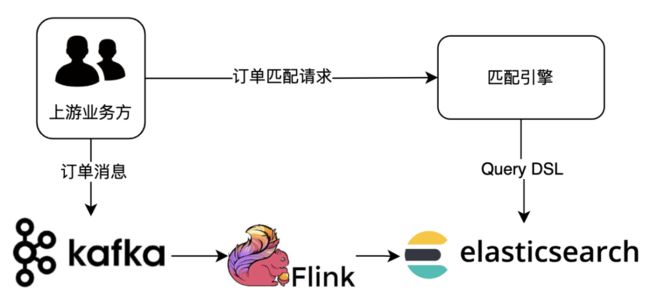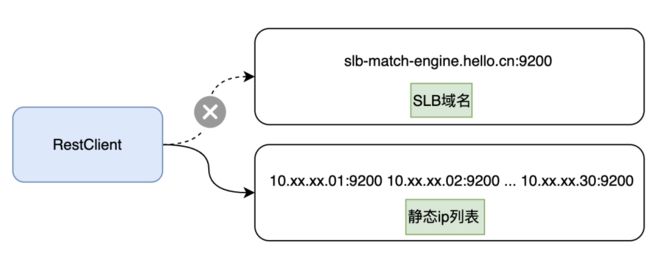背景介绍
我们小组主要负责四轮场景下的司乘匹配工作,基于开源分布式搜索引擎ElasticSearch实现订单的召回。同时我们使用Flink实时消费kafka消息,将订单数据写入到对应的ES索引中。
想要使用Elasticsearch服务,则要先创建一个可以连接到ES集群的客户端。ES官方提供了很多版本的 Java 客户端,包含但不限于:
- Transport 客户端
- Low Level REST 客户端
- High Level REST 客户端
- Java API 客户端
早期我们使用的是向SLB域名(SLB是负载均衡服务的缩写)发送请求,在SLB后面有配置对应的ES节点ip,使用SLB来实现负载均衡。但随着流量的增长,在节假日和线上压测时,经常出现SLB带宽超限的问题,影响系统的稳定性。
于是我们改用ip直连的方式,RestClient客户端本身自带ip节点的负载均衡策略,实现上使用了 Collections.rotate() 方法,感兴趣的可以可以看底层的算法思路。
虽然解决了SLB带宽超限的问题,但现在需手动配置ip列表,比较容易出错,一旦配错一个节点,就会引起线上报错,而且每次扩缩容时都要进行ip列表的变更。
于是我们开始调研节点的嗅探机制,先从官方文档入手。
官方文档给出的示例如下:
RestClient restClient = RestClient.builder(
new HttpHost("localhost", 9200, "http"))
.build();
Sniffer sniffer = Sniffer.builder(restClient)
.setSniffIntervalMillis(60000).build();上面代码的含义就是初始化一个嗅探器,每60s更新一次节点列表。
还可以启用失败嗅探,在每次请求失败之后,节点列表都会立即更新,而不是在下一轮普通的嗅探中更新。这种首先需要创建一个 SniffOnfalureListener,并在创建 RestClient 时设置一个监听器,在每次节点失败时通知该监听器。
SniffOnFailureListener sniffOnFailureListener =
new SniffOnFailureListener();
RestClient restClient = RestClient.builder(
new HttpHost("localhost", 9200))
.setFailureListener(sniffOnFailureListener)
.build();
Sniffer sniffer = Sniffer.builder(restClient)
.setSniffIntervalMillis(60000)
.build();
sniffOnFailureListener.setSniffer(sniffer);除了嗅探器之外,还发现了另一个特殊的配置:节点选择器。
节点选择器可以实现对节点列表的过滤,比如我想过滤出协调节点,只向协调节点发送请求,就可以定义一个NodeSelector来实现。
源码剖析
下面我们开始剖析Sniffer组件的底层实现,先进入build()方法:
public Sniffer build() {
if (nodesSniffer == null) {
this.nodesSniffer = new ElasticsearchNodesSniffer(restClient);
}
return new Sniffer(restClient, nodesSniffer, sniffIntervalMillis, sniffAfterFailureDelayMillis);
}我们可以看到实例化一个sniffer对象之前,先创建了一个nodeSniffer对象,指向的类型是ElasticsearchNodesSniffer,这个是真正的发送ES节点嗅探请求的类,我们待会再看。
接着来到Sniffer的构造方法,看一下作了哪些参数的初始化:
- nodesSniffer:发送节点嗅探请求的对象
- restClient:向ES集群发送请求的客户端
- sniffIntervalMillis、sniffAfterFailureDelayMillis:定时嗅探周期、失败后嗅探延迟时间
- scheduler:定时任务线程池
Sniffer(RestClient restClient, NodesSniffer nodesSniffer, Scheduler scheduler, long sniffInterval, long sniffAfterFailureDelay) {
this.nodesSniffer = nodesSniffer;
this.restClient = restClient;
this.sniffIntervalMillis = sniffInterval;
this.sniffAfterFailureDelayMillis = sniffAfterFailureDelay;
this.scheduler = scheduler;
/*
* The first sniffing round is async, so this constructor returns before nextScheduledTask is assigned to a task.
* The initialized flag is a protection against NPE due to that.
*/
Task task = new Task(sniffIntervalMillis) {
@Override
public void run() {
super.run();
initialized.compareAndSet(false, true);
}
};
/*
* We do not keep track of the returned future as we never intend to cancel the initial sniffing round, we rather
* prevent any other operation from being executed till the sniffer is properly initialized
*/
scheduler.schedule(task, 0L);
}除此之外,我们可以看到实例化了一个Task对象,同时提交任务到了线程池中,任务的延迟时间是0,说明立即执行。从注释可以看出这是初始嗅探,即应用刚启动时立即触发一轮嗅探。
我们看一下Task对象的run()方法是咋样的。Task有一个属性:nextTaskDelay,从名字可以看出是下一次执行的延迟时间,上面我们初始化时传入的参数是sniffIntervalMillis,即下一次任务在经过一个嗅探周期后执行。可以看到在finally代码块中,向线程池提交的新任务,延迟时间设置的也是nextTaskDelay。
class Task implements Runnable {
final long nextTaskDelay;
final AtomicReference taskState = new AtomicReference<>(TaskState.WAITING);
Task(long nextTaskDelay) {
this.nextTaskDelay = nextTaskDelay;
}
@Override
public void run() {
/*
* Skipped or already started tasks do nothing. In most cases tasks will be cancelled and not run, but we want to protect for
* cases where future#cancel returns true yet the task runs. We want to make sure that such tasks do nothing otherwise they will
* schedule another round at the end and so on, leaving us with multiple parallel sniffing "tracks" whish is undesirable.
*/
if (taskState.compareAndSet(TaskState.WAITING, TaskState.STARTED) == false) {
return;
}
try {
sniff();
} catch (Exception e) {
logger.error("error while sniffing nodes", e);
} finally {
Task task = new Task(sniffIntervalMillis);
Future future = scheduler.schedule(task, nextTaskDelay);
//tasks are run by a single threaded executor, so swapping is safe with a simple volatile variable
ScheduledTask previousTask = nextScheduledTask;
nextScheduledTask = new ScheduledTask(task, future);
...
}
}
} 具体的嗅探逻辑就在这个sniff()方法里了,我们接着往下看。
final void sniff() throws IOException {
List sniffedNodes = nodesSniffer.sniff();
if (logger.isDebugEnabled()) {
logger.debug("sniffed nodes: " + sniffedNodes);
}
if (sniffedNodes.isEmpty()) {
logger.warn("no nodes to set, nodes will be updated at the next sniffing round");
} else {
restClient.setNodes(sniffedNodes);
}
} 可以看到调用了nodesSniffer对象的sniff()方法,所以说这个对象才是真正用于发送ES节点嗅探请求的,只好继续看它的sniff()是怎么实现的啦。
我们发现它使用restClient向ES集群发了一次请求!
@Override
public List sniff() throws IOException {
Response response = restClient.performRequest(request);
return readHosts(response.getEntity(), scheme, jsonFactory);
} 这个请求具体是啥呢,我们在构造函数里找一找:
public ElasticsearchNodesSniffer(RestClient restClient, long sniffRequestTimeoutMillis, Scheme scheme) {
...
this.request = new Request("GET", "/_nodes/http");
...
}可以看到构造了一个Request对象,向集群发送GET请求,请求的url是/_nodes/http。
请求完成之后,需要对集群的返回结果作解析,readHosts方法主要是作一些json解析工作,我们就不细看了。最终返回一个包含集群中全部节点的Node对象列表。
static List readHosts(HttpEntity entity, Scheme scheme, JsonFactory jsonFactory) throws IOException {
try (InputStream inputStream = entity.getContent()) {
JsonParser parser = jsonFactory.createParser(inputStream);
...
return nodes;
}
} 拿到节点列表之后,当然是设置到restClient实例的属性当中去,所以回到Sniffer.sniff()方法,可以看到最后确实设置到了restClient当中。
final void sniff() throws IOException {
List sniffedNodes = nodesSniffer.sniff();
if (logger.isDebugEnabled()) {
logger.debug("sniffed nodes: " + sniffedNodes);
}
if (sniffedNodes.isEmpty()) {
logger.warn("no nodes to set, nodes will be updated at the next sniffing round");
} else {
restClient.setNodes(sniffedNodes);
}
} 好了,到这我们基本就把Sniffer组件的核心逻辑看完了,可以发现就是每次嗅探后同时向线程池提交新的嗅探任务来实现的,任务的执行时间是设置的嗅探周期。
当然,我们前面还讲到了可以设置失败嗅探,那这块又是怎么实现的呢?再看一下是怎么设置的:
SniffOnFailureListener sniffOnFailureListener =
new SniffOnFailureListener();
RestClient restClient = RestClient.builder(
new HttpHost("localhost", 9200))
.setFailureListener(sniffOnFailureListener)
.build();
Sniffer sniffer = Sniffer.builder(restClient)
.setSniffIntervalMillis(60000)
.build();
sniffOnFailureListener.setSniffer(sniffer);编码经验丰富的大佬应该看出采用的是监听器模式。监听器模式的本质就是观察者模式,先将回调函数注册到被观察对象,当被观察对象发生变化时,通过回调函数告知观察者/监听者。
我们看performRequest方法,所有向集群发送的同步请求(比如一次查询请求)最终都会调用这个方法。
private Response performRequest(final NodeTuple> nodeTuple,
final InternalRequest request,
Exception previousException) throws IOException {
RequestContext context = request.createContextForNextAttempt(nodeTuple.nodes.next(), nodeTuple.authCache);
HttpResponse httpResponse;
try {
httpResponse = client.execute(context.requestProducer, context.asyncResponseConsumer, context.context, null).get();
} catch(Exception e) {
RequestLogger.logFailedRequest(logger, request.httpRequest, context.node, e);
onFailure(context.node);
...
}
...
} 可以看到在请求执行异常时(比如查询超时、网络异常),会执行到onFailure方法,在这里就会调用监听器中的方法。
private void onFailure(Node node) {
...
failureListener.onFailure(node);
}我们看一下SniffOnFailureListener这个监听器的实现:
public class SniffOnFailureListener extends RestClient.FailureListener {
private volatile Sniffer sniffer;
@Override
public void onFailure(Node node) {
if (sniffer == null) {
throw new IllegalStateException("sniffer was not set, unable to sniff on failure");
}
sniffer.sniffOnFailure();
}
}public void sniffOnFailure() {
if (this.initialized.get() && this.nextScheduledTask.skip()) {
this.scheduler.schedule(new Task(this.sniffAfterFailureDelayMillis), 0L);
}
}可以看到确实是会立即触发一次嗅探。启用失败后嗅探的好处就是如果集群中有节点下线能够及时将其从节点列表中移除,而不用等到下一个嗅探周期。
总结
我们ES客户端的节点配置初始化从SLB域名切换到静态ip列表,目的是移除对SLB的依赖,但由于人工配置ip列表容易出错,使用ElasticSearch节点嗅探机制,减少人工操作,提高扩缩容效率。
(本文作者:方选豪)
![]()

